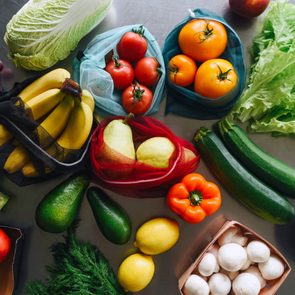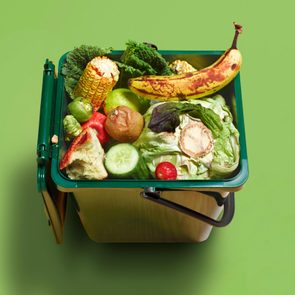Scallions vs. Green Onions: What’s the Difference?
Updated: Jun. 02, 2024

Are these vegetables actually the same thing? Here's everything you need to know.
We’ve been cooking long enough to know when we can swap out certain ingredients in our go-to recipes for others that will be just as tasty. But one ingredient pair that always trips us up is scallions vs. green onions. Are they the same thing, just known by two different names? Are they two different plants but can be used interchangeably? We set out to get the food facts for you.
Much like jam vs. jelly, sorbet vs. sherbet, gelato vs. ice cream or soup vs. stew, we’re getting to the bottom of the scallions vs. green onions debate. Here’s everything you need to know about what they are, when to use them and how they compare to similar vegetables—answering questions like “Are chives green onions?” and more.
Are scallions and green onions the same? Scallions vs. green onions
Scallions and green onions are usually the same plant, which means that, yes, they are frequently (but not always!) the same thing. They are part of the genus Allium, which is the group of vegetables and herbs that have a bulb that grows underground and includes garlic, shallots and onions (all of which we separate from the stem before eating).
Whether they are labeled as scallions or green onions is generally up to the farmer or producer who sends the foods to the grocery store; both are usually the plant allium fistulosum. This plant has long green stems that come together in a small, narrow white bulb—which isn’t much of a bulb at all when compared with a larger onion, whose bulb grows large and round.
However, the situation gets a bit more complicated with spring onions, or allium cepa. Like green onions, spring onions are harvested young, and they are roughly the same size. The biggest difference is that while scallions have the straight-sided white section on the bottom, spring onions have a distinctly round bulb that looks just like a mini white onion.
But if you harvest spring onions early, before the bulb has grown, they are also considered green onions! So green onions can be allium fistulosum or allium cepa, but scallions are always allium fistulosum. In other words, all scallions are considered green onions, but allium cepa green onions aren’t considered scallions!
Another point of confusion: In the United States, green onions and spring onions refer to two different things. But in Canada and the United Kingdom, green onions and scallions are both called spring onions. And in Mexico, spring onions are called green onions. For our purposes here in the U.S., round bulb equals spring onion and straight bulb equals scallion or green onion.
Can I use green onions in place of scallions?
Yes! Unlike baking soda vs. baking powder, which each play a distinct role in recipes, or club soda vs. seltzer water, which are going to taste slightly different from each other, you never need to worry about substituting green onions vs. scallions incorrectly. Because they are usually the same plant, scallions and green onions have the same taste. Even when green onions are allium cepa, the taste is very similar to allium fistulosum, so you can always use scallions and green onions interchangeably.
Even though it is small and straight-sided, the white bottom of the scallion or green onion tastes similar to a white onion, which is why it is typically cooked. The green part, on the other hand, has a more mild oniony flavor and doesn’t have that distinctive bite of raw onion, which is why it’s often used as a garnish. Scallions and green onions are used in a variety of cuisines, but they appear often in Asian cooking (think scallion pancakes and scallion oil).
Regardless of whether they are labeled as scallions or green onions, they are sold in bunches in the produce section. When shopping, look for sturdy, bright green stalks that aren’t slimy or limp, with firm bulbs that don’t look yellow. As long as the allium fits this description, you can use it in any recipe that calls for scallions or green onions.
Are chives and green onions the same?
Despite also being a member of the allium family, chives are not the same as green onions and scallions. Chive refers to the allium schoenoprasum plant. The green chive stems do have a similar cylindrical appearance to those of green onions, but they are much, much smaller—so small in fact, that fresh chives are typically found cut and boxed with the herbs in the produce section, while scallions and green onions are sold in bunches with the vegetables. Indeed, chives are typically cut from their bulbs before being packaged for sale, while green onions are sold with their bulbs intact.
Chives are more delicate and have a milder flavor than scallions, meaning they can wilt easily and will lose their flavor if added to a recipe too early and overcooked. For this reason, chives are typically used as a garnish, such as atop a sour-cream-dolloped baked potato or a plate of perfect scrambled eggs.
Are green onions and leeks the same?
Another member of the same family of plants is leeks, or allium ampeloprasum. While they actually look like giant scallions or green onions, with a narrow white bulb at the bottom and long green stems on top, leeks are also a different vegetable. While the green stems on green onions form small, skinny cylinders, a leek’s leaves are flat and layered on top of one another. They are also much tougher than the green part of a scallion or green onion, which is why the toughest, darkest green parts at the tops of the leaves usually aren’t eaten.
Instead, you’ll usually use the light green part and long, white bottom half in recipes, cooking them in a similar manner to regular onions. Leeks have an even milder flavor than scallions, which is why they are featured in recipes more often (think potato leek soup). Leeks are sold in bunches the same way green onions are—just make sure to give them a good wash before you use them, as dirt tends to get caught between the tightly layered leaves.
Now that you’ve mastered scallions vs. green onions, learn about the difference between oat milk vs. almond milk. Or try taking our food quiz to test your culinary smarts.
Sources:
- University of Minnesota Extension: “Growing scallions in home gardens“
- University of Minnesota Extension: “Growing chives in home gardens“
- University of Minnesota Extension: “Growing leeks in home gardens“


















